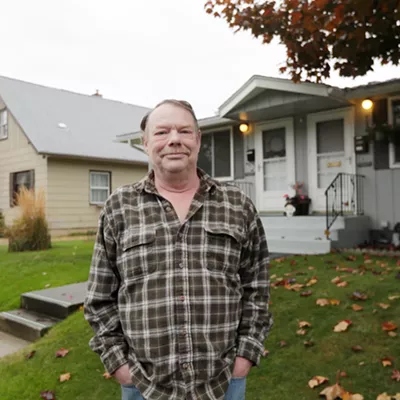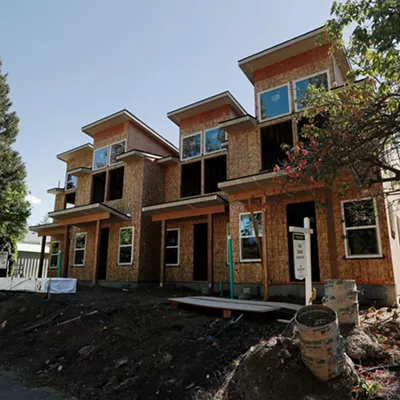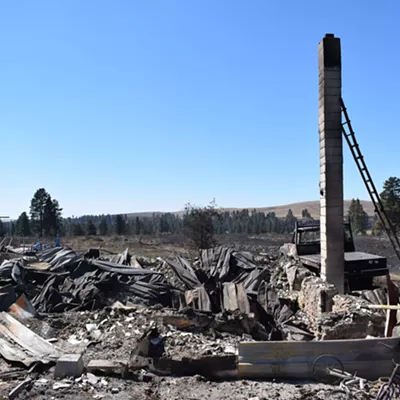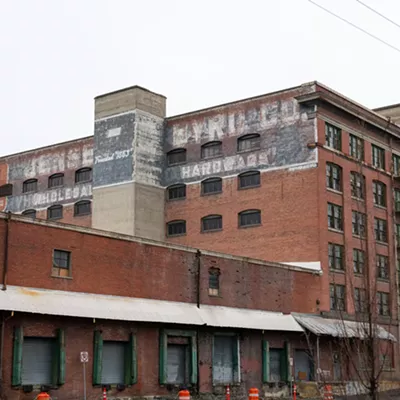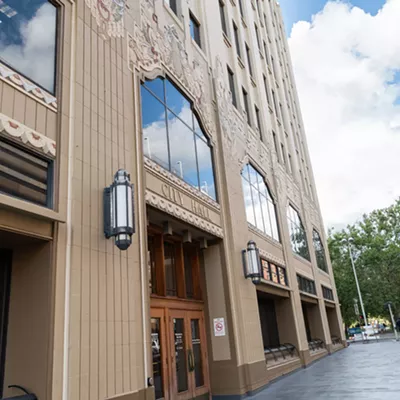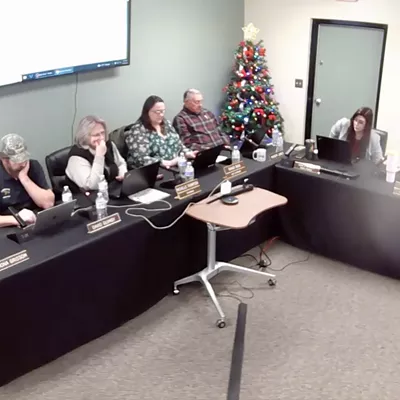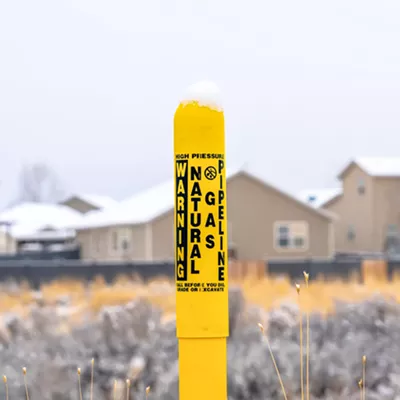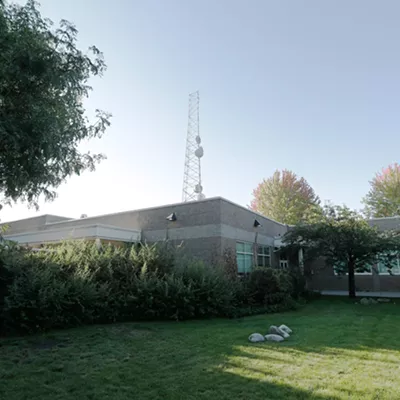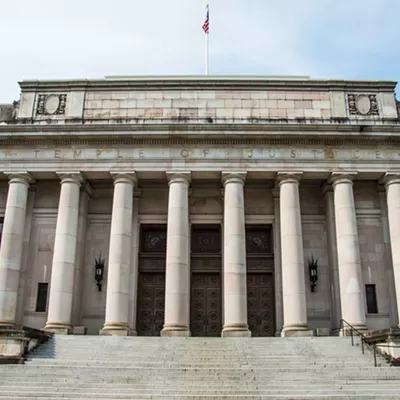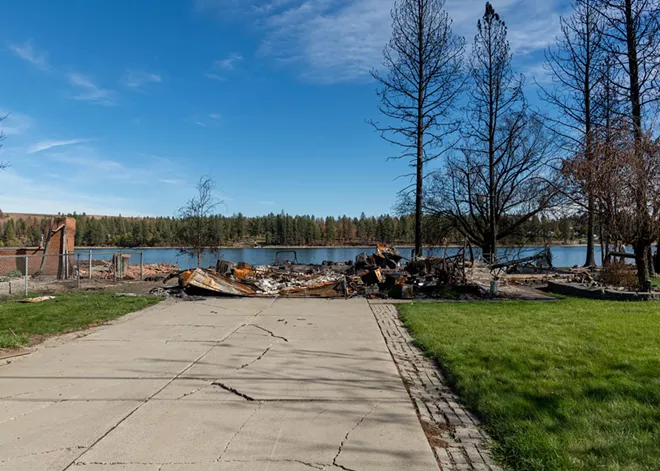
Back in February, Nikki Hyche received an unwelcome surprise. Though she'd reliably paid to insure her home in Spokane's Grandview/Thorpe neighborhood since 2015, she received a letter from Farmers Insurance stating that they wouldn't be renewing her coverage.
"We have recently reviewed your home policy and determined certain factors do not meet our eligibility rules," the nonrenewal notice stated.
Her coverage, she was informed, would end on April 30, because her roof was too old and something called her FireLine® score was too high. Hyche informed the insurance company that she'd actually gotten a new roof, but they told her the policy still wouldn't be renewed. The fire risks calculated by FireLine, a product from the insurance rating bureau Verisk, were apparently too much for Farmers to keep her on.
"I read the letter and called them and basically they said Farmers is pulling out of the [ZIP] code 99224, and they will no longer be insuring people here," Hyche says. "I felt betrayed."
While Farmers pointed Hyche toward another insurance option from a different company, she says she instead went to an independent insurance agent who shopped around and found her some options. She ultimately got another plan with a major insurance company at a comparable rate.
But not everyone has been so lucky.
Insurance brokers in the Inland Northwest have similarly started to see some clients getting their coverage "non-renewed" — industry lingo for canceled — and in some cases, it hasn't been easy to find another policy.
Lei Ann Cross is a private client adviser in Spokane for Hub International, an independent insurance agency that's able to shop around and offer a variety of insurance products from different companies. Cross says she and her coworkers have started to hear about more nonrenewals in recent years, particularly after last summer's Gray Fire near Medical Lake and Oregon Fire near Elk.
Medical Lake sits just outside the 99224 ZIP code, which covers a large area west of the city of Spokane, stretching from Riverside State Park in the north nearly to Spangle in the south and west to Four Lakes. It encompasses the area where last week's Grove Fire burned an estimated 75 acres.
The increased frequency of catastrophes is something insurance companies are taking into account, Cross says.
"It's really hard to wrap your head around when you pay your insurance every month and you don't put in a claim and all of a sudden you are getting a rate increase or you're getting non-renewed," Cross says. "It's frustrating for the client, it's frustrating for the agent, it's frustrating for the carriers themselves. They don't want to have to be pulling business. But around here we did have those two large fires last year."
The nonrenewals are compounded by major cost increases in recent years. While it's hard to quantify the two issues, there are multiple factors impacting the industry.
INCREASED PREMIUMS
Whether you have a homeowners insurance policy or commercial insurance for your business, the last two years have likely felt especially punishing.Premiums — i.e., the monthly or annual costs to customers to maintain coverage — significantly increased in 2023 and again this year.
In Washington state, 135 companies provide homeowners insurance, but the largest 20 companies make up about 75% of the insurance market, according to the state Office of the Insurance Commissioner.
The weighted average annual rate change for homeowners insurance among those top 20 companies ranged from a 1.3% to 3.9% increase each year from 2017 to 2022, according to the state agency's data. Then in 2023, customers saw a whopping 16.9% increase (on weighted average), and so far this year, customers are seeing a 14.6% increase.
Anecdotally, Cross says the largest increase she's seen was about 40%.
The primary reason homeowners insurance has been getting more expensive is due to the increase in actual claims that insurance companies have had to pay out in the state, says Aaron VanTuyl, who works in public affairs for the state Office of the Insurance Commissioner.
In 2018, insurance companies paid out nearly $942 million in homeowners insurance claims, VanTuyl says. In 2022, the payout was nearly double that, at $1.84 billion.
The final figures for 2023 aren't in yet, but it's expected to be more than $2 billion, he says.
When companies want to increase their rates, those requests have to be submitted to the Office of the Insurance Commissioner, where state-employed actuaries verify the actual costs that companies are using to forecast their future needs in setting their rates, VanTuyl says.
"They have to prove actuarially that a rate change is justified, and show a recent history of their expenses, administrative costs, and claims paid out," VanTuyl says. "They also show what their current premiums are bringing in and whether they'll lose money or become insolvent."
The state actuaries can push back if they don't feel rate increases are justified, but if they're proven necessary, the elected insurance commissioner cannot tell the companies they can't increase their rates.
Washington customers are somewhat lucky, in that they still often have other options if their insurance provider either spikes their rates or doesn't renew their coverage, Cross says. In other states, such as California, Texas and Florida, homeowners haven't been so lucky.
So what happens when you can't find coverage, and how many people is this happening to?
LAST RESORT
In Washington, if worst comes to worst, homeowners can find coverage through the FAIR Plan, which is known as an insurer of last resort. It provides very basic fire coverage, but many other things such as water damage, liability or theft are not included.While the plan isn't taxpayer funded, it is overseen by the Office of the Insurance Commissioner, which can use data from those who enroll to get a sense of why people are struggling to get insurance, VanTuyl says.
Use of the FAIR Plan has increased year over year, though homeowners often get off the plan quickly.
"For the most part they are able to find better coverage from a regular insurance company," VanTuyl says. "It's not the best coverage you can look for, but it is coverage available to anybody who needs it."
Over the course of 2017, there were 75 enrollees on the FAIR Plan in Washington. So far this year, there have been 254 enrollees, though as of last week there were 207 on the plan, VanTuyl says. There are also consumers enrolled on the commercial side.
In 2022, 59% of homeowners enrolled on the FAIR Plan in Washington said their claims history prevented them from finding other coverage, while 13% said wildfire risk was preventing them from finding coverage; in 2023, 48% blamed their claims history and 16% said wildfire risk was at fault.
Washington is still doing far better than other states that have faced significant natural disasters when it comes to how many people require last resort insurance.
In Oregon, there are about 1,300 people using that type of plan, while in California there are about 380,000, says David Forte, a senior policy adviser for the Washington state Office of the Insurance Commissioner. Florida, meanwhile, which faces severe wind damage from hurricanes (FEMA provides flood coverage), has 1.3 million on the state's insurer of last resort, he says.
"We've doubled in the last three years, but we still only have 207 on the plan. On a whole across the state, we have almost 2 million homeowners policies," Forte says. "Yes, people are being nonrenewed, but they're still able to find companies willing to cover them. If they weren't, they'd be coming to our FAIR Plan more."
The insurance commissioner's office can also look to consumer complaints as a source of data, but since May 1, 2023, the office has received only 32 complaints about homeowners insurance that mentioned wildfire, and only two of those mentioned nonrenewals, VanTuyl says.
WHAT TO DO
In his role as an adviser, Forte often speaks to groups around the state about the current insurance market and the options available to homeowners and communities that want to make sure their area remains insurable.Insurance providers aren't required to disclose which third-party companies they may be using to calculate the risks in a specific area, Forte says.
"Insurance companies aren't going on site and doing a thorough investigation. They're relying on aerial satellite imagery and third-party vendors," Forte says. "Unlike rates, where the commissioner has the authority to approve, review, push back or challenge them, when it comes to underwriting guidelines, they are not required to be disclosed to the commissioner. We have no legal authority to challenge them."
In other words, the insurance commissioner can't dictate the risks companies should take on, nor can they require that companies use the most up-to-date and accurate data available when deciding whether to renew a policy.
However, there are things communities and individual owners can do to improve their chances of remaining insurable. Among those, homeowners can update their property to an industry standard called "Wildfire Prepared Home," Forte says.
The designation is being designed by the Insurance Institute for Business and Home Safety (IBHS), an insurance industry-funded research institute.
IBHS similarly designed standards to protect homes from wind damage in the southeast part of the country, Forte says. Alabama supported homeowners with grants to make those updates (largely fortifying roofs and windows), and now has better rates and more options for insurance compared to other states in that area, he says.
However, the changes required under the Wildfire Prepared Home standards will likely be farther out of reach for the average consumer, Forte says. Upgrades could include everything from new siding to replacing wood decks with fire resistant material.
"It's more expensive than just a roof," Forte says. "This has to be monitored, and people have to do vegetation mitigation every year. It's a far greater challenge ahead of us for wildfire mitigation."
This year, the state could also move closer to understanding the scope of insurability issues.
Currently, the insurance commissioner doesn't actually track where all the various types of insurance policies are around the state, Forte says.
"We approve the language, and the rates, but we don't track who has what policy," Forte says.
However, Washington lawmakers unanimously approved a new law this year, which took effect this month and should allow the insurance commissioner's office to compile data from insurance companies to get a better idea of what's happening around the state. The new law enables the office to gather information that's often considered confidential and compile public reports that won't interfere with competitiveness in the industry, but could illuminate what's going on.
It's a balancing act, Forte says.
"We're tasked to do consumer protection, maintain a healthy market and regulate the insolvency of these companies," Forte says. "If they're willing to pull out of California, which is like the No. 4 insurance market in the entire world — not just the country — they're willing to pull out of any area they feel is not profitable." ♦



